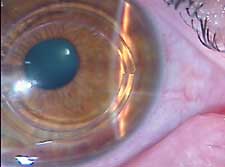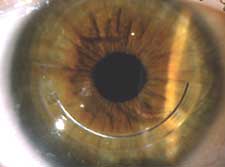One intracorneal segment treats keratoconus better than two
An ophthalmologist found that residual refractive errors were improved by implanting a toric phakic IOL 3 months later.
One inferior intracorneal ring segment achieves better results in keratoconus patients than two intracorneal ring segments, according to one ophthalmologist.
Joaquim Neto Murta, MD, PhD, learned this when he discovered that some of his keratoconic patients did not have sufficient refractive or topographic outcomes after implantation of two segments (Intacs, Addition Technology).
“I tried to take off the superior [ring] in order to increase the effect of the inferior ring, and then I realized that in those patients there was an increase in vision in some of them,” he said in an interview with Ocular Surgery News.
To determine the efficacy of this approach, Dr. Murta conducted a prospective study in which he compared the outcomes in 12 eyes implanted with two intracorneal segments with the outcomes in 12 eyes implanted with one intracorneal segment.
He presented the results at the Alicante Refractive meeting.
The mean age of the patients with two segments was 33 years, and the mean age of the patients with one segment was 25 years.
Patients were followed for 12 months or more and were assessed for anatomic and functional outcomes.
Study results
The mean preoperative spherical equivalent of the group with two segments was –3.58 D, mean preop cylinder was –2.90 D and the best corrected visual acuity was 0.30, according to Dr. Murta.
The mean preoperative spherical equivalent of the group with one segment was –4.57 D, mean preop cylinder was –2.67 D and BCVA was 0.42.
When two segments were implanted, Dr. Murta used a segment of 0.45 mm thickness inferiorly and a segment of 0.25 mm superiorly. When one segment was used, the thickness was always 0.45 mm.
“When I got to the surgery in these patients, there were always inferior cones, so it was normally 0.45 mm in the inferior part,” Dr. Murta said.
The segments were implanted horizontally through one or two intrastromal channels.
At the 12-month postoperative follow-up, the spherical equivalent in the eyes with two segments had improved to –3.52 D, whereas it had improved to –3.66 D in the group with one segment. The difference was statistically significant in the second group, according to the results.
The BCVA in the group with two segments improved to 0.55, whereas it had improved to 0.75 in the group with one segment. The difference was also statistically significant.
There was a gain of three lines or more of visual acuity in 83% of eyes with one segment compared with 75% of eyes with two segments. The group with one segment also had a gain of six lines in 33% of patients compared with no gain in the group with two segments.
“There was a significant effect between two and one rings,” he said.
|
|
Images: Murta JN |
Adjunct toric IOLs
Dr. Murta has been experimenting with implanting toric phakic IOLs such as the Artisan (Ophtec) as an adjunct to intracorneal segments in cases of residual refractive errors.
“I normally implant an intracorneal ring, and 3 months later I implant the toric IOL,” he said. “The philosophy is to make the cornea more regular, and then the second step is to correct the large ametropia with the phakic IOL.”
Dr. Murta implanted seven contact lens intolerant eyes with the Artisan phakic IOL. The patients were older than 25 years, anterior chamber depth was more than 3 mm and endothelial cell count was more than 2,000 cells/mm².
Preoperative BCVA was 20/50 or better, mean preop sphere was –6.3 D and mean preop cylinder was –3.7 D.
Current results show that at 3 months, one of these patients gained one line of visual acuity, three patients gained two lines and one gained three lines.
Dr. Murta said 3 months is the minimum amount of time to wait between the two procedures.
“To do both procedures at the same time is impossible because the predictability is not good. The minimum waiting time is 3 months. If you have a longer length of time between the two procedures, it would be best because sometimes with intracorneal rings the stabilization of the refraction takes 3 to 6 months,” he said.
For more information:
- Joaquim Neto Murta, MD, PhD, can be reached at the University Hospital Coimbra, Praceta Mota Pinto, Coimbra 3000-075, Portugal; +351-2-39-40-30-46; fax: +351-2-39-40-30-46; e-mail: jmurta@mail.telepac.pt. Dr. Murta has no direct financial interest in the products discussed in this article, nor is he a paid consultant for any companies mentioned.
- Addition Technology, the maker of Intacs, can be reached at 950 Lee St., Des Plaines, IL 60016 U.S.A.; +1-847-297-8419; fax: +1-847-297-8678; e-mail: intacs@additiontechinc.com; Web site: www.getintacs.com. Ophtec, the maker of the Artisan toric phakic IOL, can be reached at Schweitzerlaan 15, 9728 NR Groningen, The Netherlands, +31-50-525-1944; fax: +31-50-535-4386; Web site: www.ophtec.com.
- Jared Schultz is an OSN Staff Writer who covers all aspects of ophthalmology. He focuses geographically on Europe and the Asia-Pacific region.


